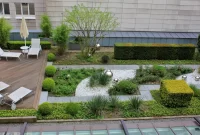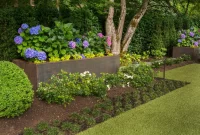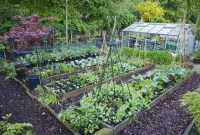If you are looking to create a stunning garden that remains beautiful all year long, then perennial gardens are the answer. With their ability to bloom throughout the seasons, these gardens offer an endless array of color and texture. Explore our guide to planting for year-round beauty and discover how to effortlessly maintain a vibrant and captivating garden.
Benefits of Growing Perennials
Perennial gardens offer a multitude of benefits, making them a popular choice for gardeners looking to add year-round beauty to their outdoor space.
1. Low Maintenance: Once established, perennial plants require minimal upkeep. Unlike annuals, they do not need to be replanted every year, saving both time and money.
2. Longevity: Perennials have a longer lifespan compared to annuals. With proper care, they can thrive and bloom for many years, providing a beautiful and ever-changing landscape.
3. Cost-Effective: Although initial costs may be higher than annual plants, perennials are a cost-effective investment in the long run. Since they return year after year, you save money on buying new plants annually.
4. Various Colors and Textures: There is a wide variety of perennials available, offering an extensive range of colors, sizes, and textures. This allows you to create a diverse and visually appealing garden design.
5. Attract Wildlife: Perennials attract pollinators such as bees and butterflies, making them essential for supporting local ecosystems. They also provide shelter and food sources for birds and other wildlife.
6. Environmental Benefits: Perennial plants have deep root systems that help improve soil quality and prevent erosion. They also require less water than annuals, reducing water consumption in the garden.
7. Continual Bloom: By selecting a combination of perennials with different blooming times, you can enjoy a continuous display of flowers throughout the growing season, ensuring year-round beauty in your garden.
Designing a Perennial Garden
Creating a beautiful perennial garden requires careful planning and consideration. By selecting the right plants and arranging them strategically, you can enjoy a garden that offers year-round beauty. Here are some essential guidelines to keep in mind when designing your perennial garden:
1. Determine your Garden’s Purpose
Before getting started, think about the purpose of your garden. Do you want to attract pollinators, create a peaceful sanctuary, or display a vibrant array of colors? Understanding your garden’s purpose will help you choose the appropriate plants and design elements.
2. Assess the Site and Soil
Take note of your garden’s sunlight exposure, drainage, and soil type. Different plants thrive in different conditions, so it’s essential to choose plants that are suitable for your specific site. Consider conducting a soil test to determine its pH level and make any necessary amendments.
3. Select a Variety of Perennials
Include a diverse selection of perennial plants in your garden to ensure year-round interest. Choose plants that bloom at different times throughout the seasons, providing visual appeal and color from spring to autumn. Additionally, consider incorporating plants with different heights, textures, and foliage characteristics for added visual interest.
4. Group Plants Strategically
Grouping plants with similar water, sun, and soil requirements together will make garden maintenance easier. This technique not only ensures that each plant receives the care it needs but also helps create visually appealing combinations of colors and textures.
5. Plan for Continual Bloom
For a garden that delights all year, aim to have plants that bloom during different seasons. Research the flowering times of your chosen perennials to create a garden that offers a succession of blooms from early spring until late fall.
6. Incorporate Hardscape Elements
Add dimension and structure to your perennial garden by incorporating hardscape elements such as pathways, garden arches, or decorative containers. These features not only provide visual interest but also help create balance and focal points within the garden.
7. Consider Maintenance Needs
Lastly, consider the level of maintenance you are willing to commit to. Some plants may require regular pruning, deadheading, or dividing. Choose plants that match your desired level of involvement to ensure your garden remains well-maintained and enjoyable.
Designing a perennial garden is an exciting and rewarding endeavor. By following these guidelines and incorporating your personal touch, you can create a garden that brings joy and beauty year after year.
Care and Maintenance of Perennials
Perennial gardens offer the opportunity to enjoy beautiful flowers and plants year-round. To ensure the longevity and vibrant beauty of your perennial plants, it is important to provide them with proper care and maintenance.
1. Planting:
When planting perennials, choose a location that receives adequate sunlight and has well-drained soil. Dig a hole slightly larger than the plant’s root ball and gently loosen the roots before placing it in the hole. Ensure the plant is level with the soil surface and fill the hole with soil, pressing firmly but not compacting it.
2. Watering:
Water newly planted perennials thoroughly and regularly. Once established, most perennials prefer a consistent level of moisture, so water deeply and less frequently rather than with shallow, frequent watering. Mulching around the plants can help retain moisture and prevent weed growth.
3. Pruning and Deadheading:
Regular pruning and deadheading will encourage continuous blooming and maintain a tidy appearance. Remove faded or dead flowers and stems to redirect the plant’s energy towards new growth. Prune back overgrown or leggy perennials in early spring to promote compact growth.
4. Fertilizing:
Perennials generally require less fertilizer than annuals. Prioritize organic fertilizers or slow-release granules that will provide a steady supply of nutrients. Apply fertilizer in early spring, following the instructions on the packaging, and avoid over-fertilizing to prevent excessive growth or damage to the plant.
5. Protection:
Protect your perennials from pests, diseases, and harsh weather conditions. Regularly inspect your plants for any signs of damage or infestation, and take appropriate action if necessary. Provide support, such as stakes or cages, for taller perennials to prevent bending or breaking under heavy winds.
By following these care and maintenance practices, your perennial gardens will thrive and reward you with year-round beauty. However, remember that each type of perennial may have specific care requirements, so it’s essential to familiarize yourself with the needs of your particular plants.
Combining Perennials with Annuals
When creating a perennial garden that boasts year-round beauty, incorporating annuals into the design can add an extra dimension to the overall visual appeal. By combining both types of plants, gardeners can enjoy the longevity of perennials along with the vibrant colors and constant blooming of annuals.
Perennials are known for their longevity and the ability to come back year after year. They provide a solid foundation for any garden, offering a variety of foliage textures and blooming periods. By selecting a mix of perennials with different bloom times, you can ensure flowers throughout the growing season. Plants like coneflowers, black-eyed Susans, and daylilies are excellent choices, as they add beautiful splashes of color to any garden.
Annuals, on the other hand, only live for one season. However, they compensate for their short lifespan by offering endless blooms and a wide range of colors. They are perfect for filling in any empty spaces in the garden or creating vibrant borders. Petunias, marigolds, and zinnias are popular annual choices due to their captivating colors and easy care.
Combining perennials and annuals allow for flexibility in the garden design. Placing annuals strategically around perennials can create continuous waves of color and extend the lifespan of the garden’s visual interest. As the perennials go through their bloom cycles, the annuals keep the garden vibrant and alive. This combination ensures that there is always something new and exciting to see in the perennial garden, regardless of the season.
Additionally, the dynamic contrast between the height, texture, and color of perennials and annuals can create a visually stunning landscape. Using tall perennial flowers like delphiniums or lupines as a backdrop and planting lower-growing annuals in the foreground provides depth and dimension to the garden beds.
In conclusion, the combination of perennials with annuals offers a winning formula for creating a perennial garden that shines year-round. By carefully selecting a mix of both types of plants and considering their placement, gardeners can achieve a visually appealing and ever-changing landscape that brings joy and beauty throughout the seasons.
Conclusion
Creating a perennial garden allows for year-round beauty and enjoyment. By carefully selecting and planting a variety of perennials, gardeners can experience a continuous display of colorful blooms and foliage throughout the seasons. With proper care and maintenance, these plants will continue to thrive and provide an ever-changing landscape for years to come.







